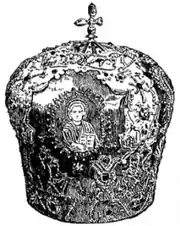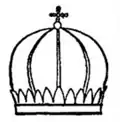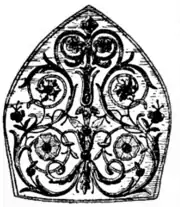MITROVICA—MITSCHERLICH
627
an actual mitre or the figure of one was sometimes carried,
and sometimes suspended over the tomb” (Report on the Ornaments of the Church, p. 106). The liturgical use of the mitre was revived in the Church of England in the latter part of the 19th century, and is now fairly widespread.
3. Oriental Rites.—Some form of liturgical head-dress is common
to all the Oriental rites. In the Orthodox Eastern Church
the mitre (Gr. μίτρα; Slav. mitra) is, as in the Western Church,
proper only to bishops. Its form differs entirely from that

Drawn from a photograph taken by Father J. Braun (reproduced in Die liturgische Gewandung). By permission of B. Herder.
Fig. 2—Greek Mitre.
of the Latin Church. In
general it rather resembles
a closed crown, consisting
of a circlet from which rise
two arches intersecting
each other at right angles.
Circlet and arches are richly
chased and jewelled; they
are filled out by a cap of
stiff material, often red
velvet, ornamented with
pictures in embroidery or
appliqué metal. Surmounting
all, at the intersection
of the arches is a cross.
In Russia this usually lies
flat, only certain metropolitan,
and by prescription
the bishops of the
eparchy of Kiev, having
the right to have the cross
upright (see fig. 2). In the
Armenian Church priests and archdeacons, as well as the
bishops, wear a mitre. That of the bishops is of the Latin
form, a custom dating from a grant of Pope Innocent III.; that
of the priests, the sagvahart, is not unlike the Greek mitre (see
fig. 3).

From Braun’s Liturgische Gewandung. By permission of B. Herder.
Fig. 3—Mitre of Armenian Priest.
In the Syrian Church only the
patriarch wears a mitre, which resembles that
of the Greeks. The biruna of the Chaldaean
Nestorians, on the other hand, worn by all
bishops, is a sort of hood ornamented with
a cross. Coptic priests and bishops wear
the ballin, a long strip of stuff ornamented
with crosses &c., and wound turban-wise
round the head; the patriarch of Alexandria
has a helmet-like mitre, the origin of which
is unknown, though it perhaps antedates the
appearance of the phrygium at Rome. The
Maronites, and the uniate Jacobites, Chaldaeans and Copts
have adopted the Roman mitre.
The mitre was only introduced into the Greek rite in comparatively
modern times. It was unknown in the earlier part

Reproduced by kind permission of the Archbishop of Westminster.
Fig. 4—Mitra pretiosa of the late Cardinal Vaughan, Roman Catholic Archbishop of Westminster.
of the 15th century, but had
certainly been introduced by
the beginning of the 16th.
Father Braun suggests that
its assumption by the Greek
patriarch was connected with
the changes due to the capture
of Constantinople by the Turks.
Possibly, as its form suggests, it
is based on the imperial crown
and symbolized at the outset
the quasi-sovereignty over
the rayah population which
Mahommed II. was content to
leave to the patriarch. In
1589 it was introduced into
Russia, when the tsar Theodore
erected the Russian patriarchate
and bestowed on the new
patriarch the right to wear the
mitre, sakkos and mandyas, all borrowed from the Greek rite.
A hundred years later the mitre, originally confined to the
patriarch, was worn by all bishops.
See J. Braun, S.J., Die liturgische Gewandung (Freiburg-im-Breisgau, 1907), pp. 424–498. The question of the use of the mitre in the Anglican Church is dealt with in the Report of the Sub-Committee of the Convocation of Canterbury on the Ornaments of the Church and its Ministers (1908). See also the bibliography to the article Vestments.
(W. A. P.)
MITROVICA (Hungarian, Mitrovicz; German, Mitrowitz), a town of Croatia-Slavonia, Hungary, situated on the river Save, in the county of Syrmia. Pop. (1900), 11,518. Mitrovica is on the railway from Agram, 170 m. W.N.W. to Belgrade, 38 m. E. by S. Roman remains have been discovered in its neighbourhood, and it occupies the site of Sirmium or Syrmium, the chief city of Lower Pannonia under Roman rule. The emperor Probus (232–282) was born and buried at Sirmium, where, according to some authorities, the emperor Marcus Aurelius (121–180) also died; but this is uncertain. In 351, 357 and 358, ecclesiastical councils of some importance met at Sirmium, which became an episcopal see about 305, and was united with the diocese of Bosnia in 1773. The city was sacked by the Huns in 441, and by the Turks, who destroyed all its ancient buildings, in 1396 and 1521.
MITSCHERLICH, EILHARDT (1794–1863), German chemist,
was born on the 7th of January 1794 at Neuende near Jever, in the grand duchy of Oldenburg, where his father was pastor. His uncle, Christoph Wilhelm Mitscherlich (1760–1854), professor at Göttingen, was in his day a celebrated scholar. He was educated at Jever under the historian F. C. Schlosser, when he went to Heidelberg in 1811, devoted himself to philology, giving special attention to the Persian language. In 1813 he went to Paris to obtain permission to join the embassy which Napoleon I. was to send to Persia. The events of 1814 put an end to this, and Mitscherlich resolved to study medicine in order that he might enjoy that freedom of travel usually allowed in the East to physicians. He began at Göttingen with the study of chemistry, and this so arrested his attention that he gave up the journey to Persia. From his Göttingen days dates the treatise on certain parts of Persian history, compiled from MSS. in the university library and published in Persian and Latin in 1814, under the title Mirchondi historia Thaheridarum historicis nostris hucusque incognitorum Persiae principum. In 1818 he went to Berlin and worked in the laboratory of H. F. Link (1767–1851). There he made analyses of phosphates and phosphites, arsenates and arsenites, confirming the conclusions of J. J. Berzelius as to their composition; and his observation that corresponding phosphates and arsenates crystallize in the same form was the germ from which grew the theory of isomorphism which he communicated to the Berlin Academy in December 1819. In that year Berzelius suggested Mitscherlich to the minister Altenstein as successor to M. H. Klaproth at Berlin. Altenstein did not immediately carry out this proposal, but he obtained for Mitscherlich a government grant to enable him to continue his studies in Berzelius’s laboratory at Stockholm. He returned to Berlin in 1821, and in the summer of 1822 he delivered his first lecture as extraordinary professor of chemistry in the university, where in 1825 he was appointed ordinary professor. In the course of an investigation into the slight differences discovered by W. H. Wollaston in the angles of the rhombohedra of the carbonates isomorphous with calc-spar, he observed that the angle in the case of calc-spar varied with the temperature. On extending his inquiry to other aelotropic crystals he observed a similar variation, and was thus led, in 1825, to the discovery that aelotropic crystals, when heated, expand unequally in the direction of dissimilar axes. In the following year he discovered the change, produced by change of temperature, in the direction of the optic axes of selenite. His investigation (also in 1826) of the two crystalline modifications of sulphur threw much light on the fact that the two minerals calc-spar and aragonite have the same composition but different crystalline forms, a property which Mitscherlich called dimorphism. In 1833 he made a series of careful determinations of the vapour densities of a large